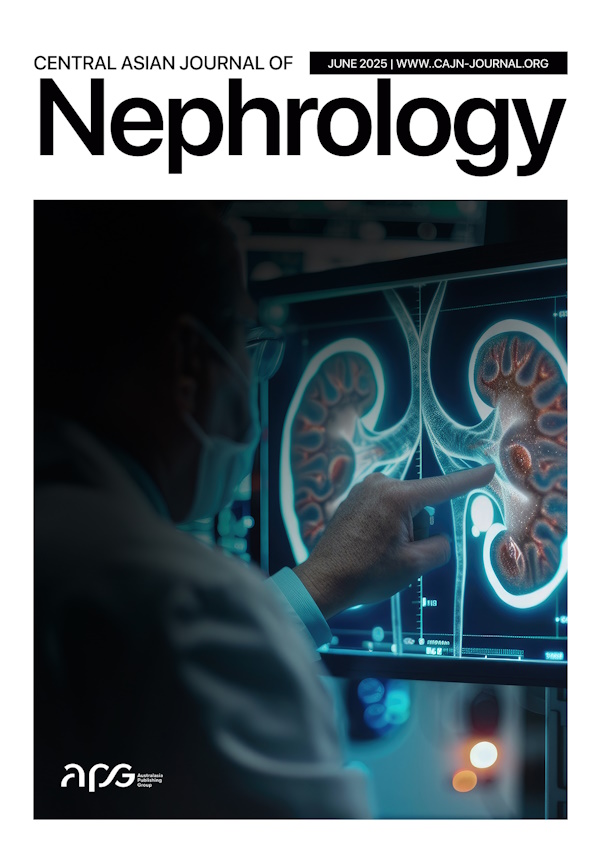
Keyword: Kazakhstan
2 results found.
Original Article
Central Asian Journal of Nephrology, 1(2), 2025, cajn007, https://doi.org/10.63946/cajn/17084
ABSTRACT:
Background: Chronic kidney disease (CKD) is a major global health challenge, yet population-based data from Central Asia are scarce. We conducted a population-based screening study to assess kidney function distribution and associated risk factors in Astana, Kazakhstan.
Methods: In March 2024, 636 adults were screened through convenience sampling at four major institutions in Astana. After excluding incomplete data, 569 participants were analyzed. Demographic, lifestyle, and clinical information were collected, and serum creatinine was used to estimate glomerular filtration rate (eGFR). Reduced renal function was defined as eGFR <90 mL/min/1.73 m². Group comparisons and logistic regression analyses were performed to identify risk factors for reduced renal function.
Results: The median age of participants was 46 years (IQR 33–55), and 79.8% were women. Median eGFR was 92.8 (IQR 79.8–111.3) mL/min/1.73 m²; 54.1% had eGFR ≥90, 42.4% had eGFR 60–89, and 3.5% had eGFR 45–59. Reduced renal function was more common among older adults, females and those with hypertension and heart failure. In multivariable analysis, older age and female sex were independent predictors of reduced renal function. Awareness was low: only 15.0% of individuals with eGFR 45–59 reported having CKD.
Conclusion: This study provides the population-based evidence on kidney function in Astana, Kazakhstan. Reduced renal function was common, particularly among older adults. Findings highlight the importance of population-based screening and targeted prevention strategies to address kidney health in Kazakhstan.
Methods: In March 2024, 636 adults were screened through convenience sampling at four major institutions in Astana. After excluding incomplete data, 569 participants were analyzed. Demographic, lifestyle, and clinical information were collected, and serum creatinine was used to estimate glomerular filtration rate (eGFR). Reduced renal function was defined as eGFR <90 mL/min/1.73 m². Group comparisons and logistic regression analyses were performed to identify risk factors for reduced renal function.
Results: The median age of participants was 46 years (IQR 33–55), and 79.8% were women. Median eGFR was 92.8 (IQR 79.8–111.3) mL/min/1.73 m²; 54.1% had eGFR ≥90, 42.4% had eGFR 60–89, and 3.5% had eGFR 45–59. Reduced renal function was more common among older adults, females and those with hypertension and heart failure. In multivariable analysis, older age and female sex were independent predictors of reduced renal function. Awareness was low: only 15.0% of individuals with eGFR 45–59 reported having CKD.
Conclusion: This study provides the population-based evidence on kidney function in Astana, Kazakhstan. Reduced renal function was common, particularly among older adults. Findings highlight the importance of population-based screening and targeted prevention strategies to address kidney health in Kazakhstan.
Short Communication
Central Asian Journal of Nephrology, 1(1), 2025, cajn005, https://doi.org/10.63946/cajn/16888
ABSTRACT:
The advent of targeted complement inhibitors represents a paradigm shift in managing complement-mediated nephropathies. Integrating these therapies into healthcare systems, particularly in resource-variable settings, requires strategic planning.
A national council of experts was convened in October 2024 with the purpose of obtaining a clinical expert opinion to develop practical recommendations for improving the organization and optimization of medical care for patients with C3 glomerulopathy (C3G) and IgA nephropathy (IgAN) in Kazakhstan.
The council identified critical systemic gaps, including inconsistent use of renal biopsy, lack of specialized nephropathology, absence of treatment algorithms, and fragmented patient care. A consensus was reached on key recommendations for a new national clinical protocol. These include mandating pathological confirmation, creating detailed treatment and monitoring algorithms, establishing a national registry and coordination center, and investing in specialized training for healthcare professionals.
The systematic framework proposed by the council provides an actionable roadmap to overcome barriers to care. This model ensures equitable patient access to novel therapies and may serve as a blueprint for other nations navigating the integration of advanced treatments into clinical practice.
A national council of experts was convened in October 2024 with the purpose of obtaining a clinical expert opinion to develop practical recommendations for improving the organization and optimization of medical care for patients with C3 glomerulopathy (C3G) and IgA nephropathy (IgAN) in Kazakhstan.
The council identified critical systemic gaps, including inconsistent use of renal biopsy, lack of specialized nephropathology, absence of treatment algorithms, and fragmented patient care. A consensus was reached on key recommendations for a new national clinical protocol. These include mandating pathological confirmation, creating detailed treatment and monitoring algorithms, establishing a national registry and coordination center, and investing in specialized training for healthcare professionals.
The systematic framework proposed by the council provides an actionable roadmap to overcome barriers to care. This model ensures equitable patient access to novel therapies and may serve as a blueprint for other nations navigating the integration of advanced treatments into clinical practice.


